


Frank Petras
John R. Wood
Christie’s International Real Estate
239.595.2221 fpetras@FrankPetras. com www.FrankPetras.
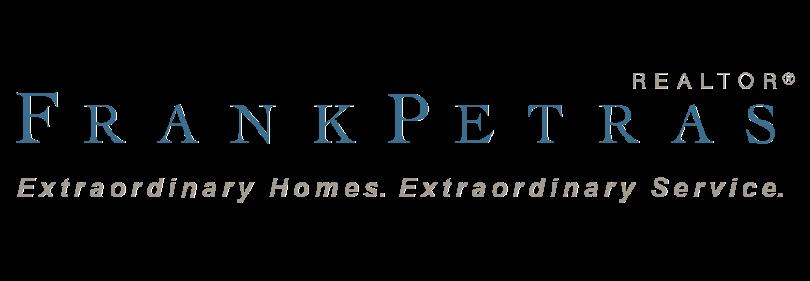





Frank Petras
John R. Wood
Christie’s International Real Estate
239.595.2221 fpetras@FrankPetras. com www.FrankPetras.


Dear «First Name»
Gather. As the weather shifts to cooler temps and the holiday magic begins, I am excited to share with you another welcoming edition of The High End. This collection of stories, from luxury decor and dining to wedding trends and travel ideas, is perfect to explore during the season of gathering. Conversation starters and uplifting spirits will be aplenty in this issue.
Dinner parties, holiday celebrations, and nights away from the cold are around the corner, and in Treasures, you’ll find the luxury products you need to elevate your dining table and impress your guests. If you’re not gathering at home, delve into Food to explore the world of multisensory dining at restaurants. This unique experience engages all your senses to enhance your culinary adventures.
For travel enthusiasts who always book a trip this time of the year, our Passport section offers a curated journey through Greece, focusing on boutique luxury and other cultural wonders. For another cozy touch, turn to Decor to browse the evolution of fabulous fireplaces. From traditional French limestone mantels to contemporary sculptural designs, learn how these functional hearths are becoming statement pieces in luxury residences and more.
Depending on where you call home, this selection of inviting articles can be enjoyed from anywhere around the world. Whether you’re nestled in a cozy mountain chalet or lounging in a sleek, oceanfront estate, these stories are bound to impress. Enjoy The High End, with my compliments.


Volume 14, Number 4


DIRECTOR, PUBLISHING & DIGITAL PRODUCTION
Kristen Ordonez
ART DIRECTOR Jonathan Bayley
SENIOR EDITOR & DIGITAL CONTENT MANAGER
Marlene Ridgway
EDITORIAL/ADVERTISING COORDINATORS
Jamie Yoos, Jack Boles
EDITORIAL OFFICE 877.688.1110 / 609.688.1110
Fax: 609.688.0201 / krussell@uniquehomes.com
186 Princeton-Hightstown Road, Bldg. 3, Suite 13 West Windsor, NJ 08550
4 ARCHITECTURE
Modernism on the Beach
Mid-century modernism in The Hamptons.
8 FOOD
Dining and Beyond
Immersive multi-sensory dining.
11 DESIGN
Designing with Distinction. Q&A with designer Jaqui Seerman.
14 GREEN
Cultivating a Serene Space Plantscaping can transform your home.
8 4 17
17 PASSPORT
Everyone’s Going
Greece is the ultimate luxury destination.

ADVERTISING
The High End is published by Unique Homes Media, Inc.
• If you would like to use The High End in your marketing plans, contact one of our sales representatives:
Stuart Santos, President 704.497.6427 / stuart@uniquehomes.com
Nick Antonicello, 310.574.1907 nantonicello@uniquehomes.com
Sheri Norris, 813.760.2264 snorris@uniquehomes.com
20 ART
Capture the Magic
Live
24 TREASURES
High-end Hosting Essentials
These luxury items are sure to cultivate an unforgettable experience.
26 WELLNESS
Southwestern Serenity
Discover the mystical allure of the Arizona and cultivate your inner calm.
30 DECOR
Fabulous Fireplaces
These architectural features ignite the imagination.
32 TRENDING
Expert Design Insights
What is shaping today’s most exquisite interiors.




By Roger Grody
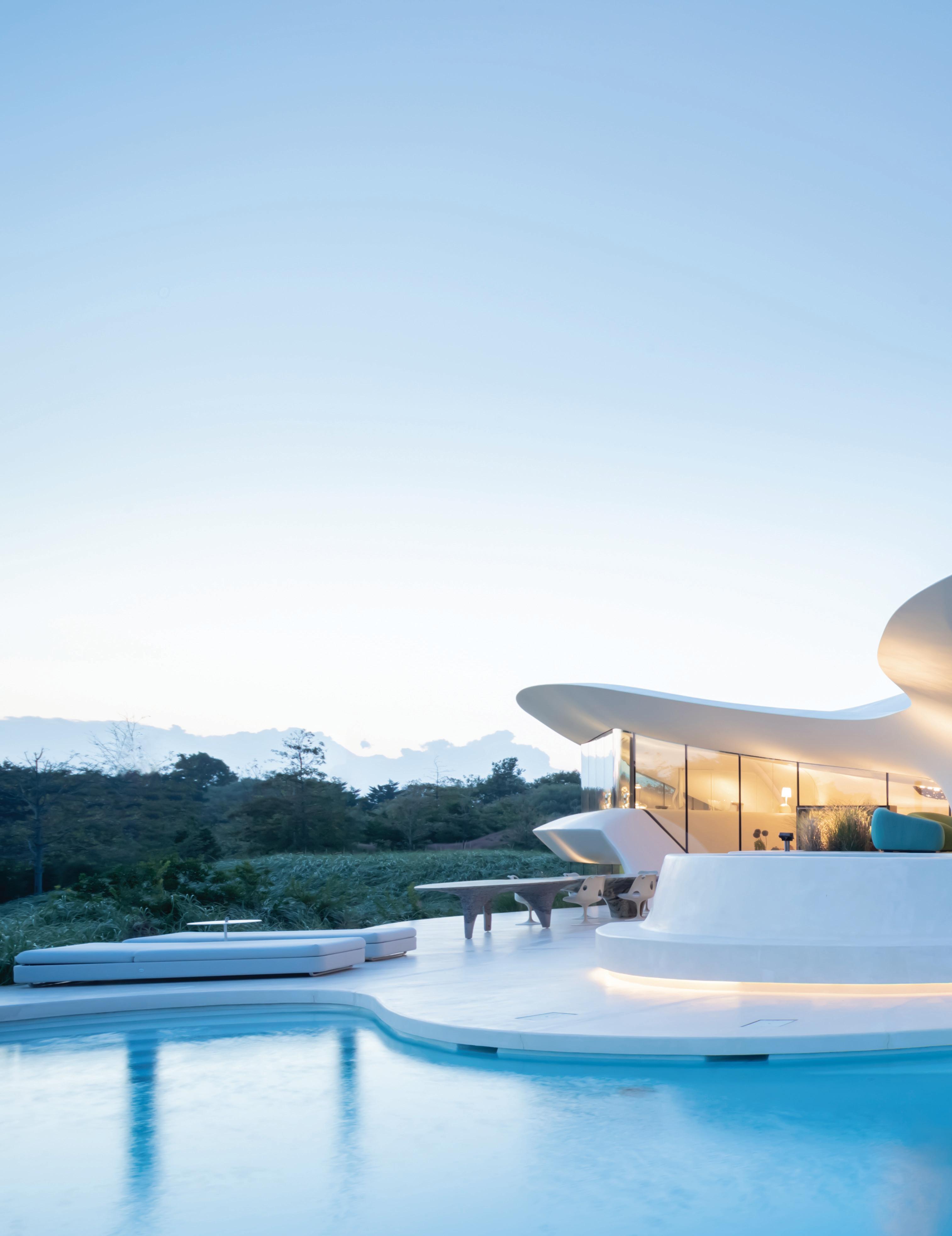
The Hamptons feature a wealth of mid-century modern residences, but economic pressures threaten landmarks in this oceanside retreat.
The magic of mid-century modern architecture is that homes from the era appear as contemporary today as when they were designed three-quarters of a century ago. The most celebrated examples are in Southern California, but the Hamptons claims its share of masterpieces as well. Sadly, with the exclusive enclave’s stratospheric real estate prices, some architectural treasures are being written off as teardowns.
The Hamptons, a two-hour drive from Manhattan on the eastern end of Long Island, is one of the most storied summertime resort destinations for discerning New Yorkers and more. Billionaire hedge fund managers, Grammy-winning hip hop artists, and Hollywood stars share this legendary stretch of coastline and its laid-back but status-conscious hamlets. Among the region’s current luminaries are Robert De Niro, Steven
PHOTO BY IWAN BAAN
Spielberg, Jerry Seinfeld, and celebrity chef Ina Garten. Fortune 500 CEOs and Wall Street titans regularly claim properties in the Hamptons, where prevailing architectural themes include shingle style, Colonial, and farmhouse. But there is also a strong heritage of mid-century modernism in the Hamptons, and contemporary architects that are inspired by 20th-century masters are perpetuating sleek, modern aesthetics on the beach.
Susan Horowitz, a leading authority on mid-century modernism around the world, is director of preservation projects at Hamptons 20th Century Modern. Founded by interior designer Timothy Godbold, the nonprofit began as an Instagram account during the pandemic and was quickly discovered
by world-class architects, journalists, and historians. The young organization has been instrumental in honoring the design style and securing its legacy in the Hamptons. Horowitz says of the local modernist heritage, “It’s hugely important because the iconic architects that worked here have influenced other areas across the country.” Horowitz points to the Saltzman House, designed by Richard Meier who would go on to earn the internationally coveted Pritzker Architecture Prize. This 1969 East Hampton home with white, curvilinear design was inspired by Le Corbusier and it remains in pristine condition.
Another home cited by Horowitz is the Scull House (aka Onna House) in East Hampton designed by Bauhaus School-influenced
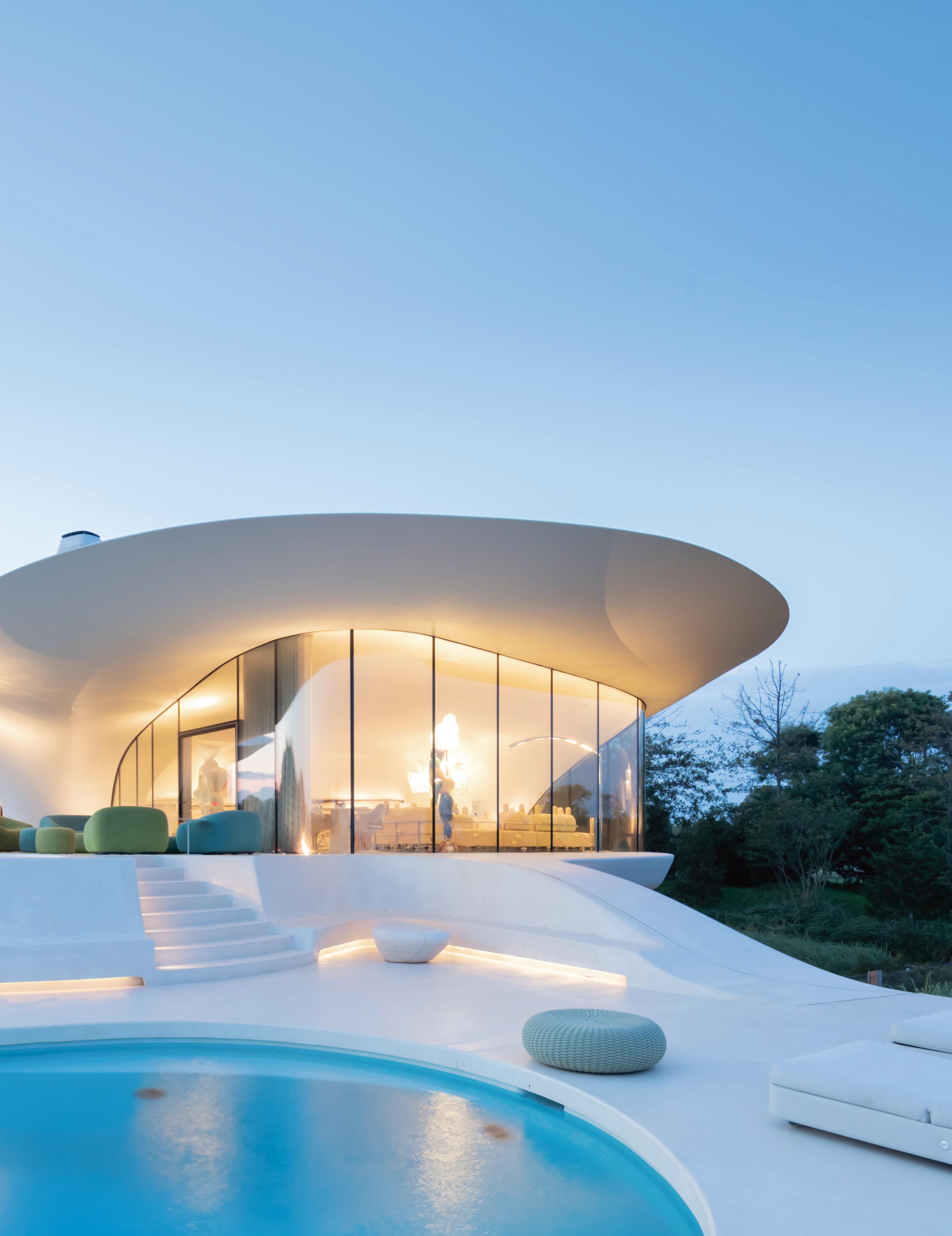
Inspired by the rolling dunes of the Hamptons coastline is Blue Dream, a curvaceous contemporary interpretation of mid-century modernism by acclaimed architects DillerScofidio + Renfro.
Paul Lester Wiener, a 1962 glass-and-steel structure now used as a gallery for female artists and designers.
Unfortunately, many significant homes in the Hamptons have been lost, not only because of inadequate landmark protections but also excessive property values. “Modernist homes in other parts of the country sit on real estate valued at a fraction of what we see here, and developers want to build the maximum square footage the site allows,” explains Horowitz. The architecture expert, a longtime resident of New York City and the Hamptons, has also lived in Los Angeles. Noting that city’s wealth of celebrated homes by Richard Neutra and Rudolph Schindler, and more, Horowitz states, “L.A. inspires me because I’ve seen

A contemporary residence by Bates Masi + Architects, inspired by the site’s previous home from a disciple of midcentury master Marcel Breuer.
the trajectory of appreciation for modernism there.” Through her work with Hamptons 20thCentury Modern, she hopes to instill that same level of appreciation on the rarefied coast.
In August, the organization collaborates with Hamptons Cottages & Gardens (HC&G) magazine to offer The Hamptons 20th Century Modern Home Tour, recently completing its third annual event. The effort, which broadens the exposure of mid-century modern architecture and its role in the heritage of the Hamptons, is a miniature version of Palm Springs’ Modernism Week, which has been remarkably successful in showcasing the architecture of that Southern California desert community. There are notable parallels between the Hamptons and Palm Springs, both being resort destinations within a twohour drive of a major city. Susan Horowitz, a regular participant at the Palm Springs confab, reports that advice from Modernism Week staff has been invaluable to its fledgling East Coast counterpart.
Tara Cubie is the preservation director at Preservation Long Island, a nonprofit dedicated to protecting the region’s cultural and architectural heritage. She reports, “From the early 20th century avant-garde movement to contemporary creators, the Hamptons

A recent home by Bates Masi + Architects captures the mid-century modern design heritage of the Hamptons.
has been a haven for artists.” Noting that the region’s modernist movement reflected a broader sociocultural evolution, Cubie says of the mid-century modern years, “The postWorld War II era brought about a desire for innovation and progress, manifested in the architectural experimentation seen in the Hamptons.” She explains that forward-thinking architects were attracted to a scenic coastline where they could integrate their design concepts with the natural environment. “The Hamptons deserves to be showcased as a center for mid-century modernism, along with places like New Canaan [Connecticut], Los Angeles, and Palm Springs,” she suggests.
“Despite the significance of modernist architecture in the Hamptons, the region faces immense pressure from development,”
advises Cubie. Concurring with Susan Horowitz, she reports, “The land’s high value often leads to the demolition of modernist treasures to make way for new, larger homes.” Cubie explains that despite local landmark designation programs, some mid-century modern residences have fallen through the cracks because they did not conform to traditional perceptions of what is historic. In addition, many mid-century modern homes are too small to meet the needs of Hamptons luxury buyers, who gravitate toward extravagant properties.
Unlike New York City, known for its stringent landmark protection, architecturally significant properties in the Hamptons are vulnerable and the works of renowned architects have been lost. Among the


homes destroyed was the Farney House in Sagaponack, designed by mid-century luminary Philip Johnson a few years before his iconic Glass House in New Canaan. Another was the Lloyds House in East Hampton, considered one of the best works of Norman Jaffe, a prolific local architect with a national reputation.
Like other revolutionary trends, midcentury modern homes were not always positively received by locals when they were built in the 1950s or 1960s. Fortunately, appreciation for the genre continues to grow through the advocacy of organizations like Hamptons 20th Century Modern and Preservation Long Island. “We’re looking forward to creating a training program to educate realtors,” says Cubie, who explains,
“Many architecturally significant properties are currently being marketed as teardowns, so buyers don’t even realize the gems they’re acquiring.”
While projects are imprinted with their designers’ own signatures, some contemporary architects active in the Hamptons are paying tribute to the midcentury masters that came before them. East Hampton-based Bates Masi + Architects is unique in the sense that it is a contemporary firm but was founded within the midcentury era, in 1965. Principal Paul Masi, who previously worked for Richard Meier, reports, “The early homes designed by our firm are still relevant and coveted today, and that spirit has transcended our work over the years.” Masi adds, “The mid-century modern homes
A home designed by Paul Lester Wiener in 1962, now a gallery for female designers and artists.
remain timeless, appearing as though they were built quite recently.”
Acknowledging that many Hamptons clients favor Colonial or shingle-style, Masi states, “Our work is respectful to traditional styles but has a spirit of modernism.” Illustrating the firm’s ability to bridge its own heritage with contemporary sensibilities is a Bates Masi project in East Hampton. There, a new residence was inspired by the home that originally occupied the site, designed by a disciple of legendary Bauhaus student Marcel Breuer. And in Bridgehampton, the firm integrated new construction with existing structures by mid-century architect Andrew Geller. Like other firms in the Hamptons, much of the work of Bates Masi + Architects continues to be influenced by the trailblazing modernists of the 20th century.
Among the most striking contemporary residences in the Hamptons is Blue Dream by Diller Scofidio + Renfro, the acclaimed firm that designed the High Line in Manhattan. The 2017 project is chronicled in a book by Pulitzer Prize-winning architectural critic Paul Goldberger, himself a longtime Hamptons resident. The curvaceous white structure, a dramatically futuristic expression, was inspired by the rolling dunes of the Long Island coast and its organic form features a lightweight fiberglass fabrication borrowed from the aerospace industry. ♦
By Ellen Paris

Across the globe, cuisines are elevated with components that awaken not just our tastebuds, but also our eyes, ears, noses, and sense of touch. These chefs continuously seek to enhance the dining experience with more than just flavors and ingredients.
Chef Jeremy Houghton, associate professor and department chair at the College of Food Innovation & Technology at Johnson
& Wales University in Providence, Rhode Island, dines at immersive destinations with top chefs worldwide. “Dining isn’t just food presented on a plate anymore. It’s become much more sensory,” Houghton observes. “Chefs now incorporate dishes with colors that make people enjoy their food more as part of the sensory experience,” he adds.
A frequent international traveler, Houghton enjoyed a unique dinner in Barcelona over the summer. “I ate at Enigma, where there were 27 courses all prepared tableside by the chef. It was an entire sensory experience,
from the tomatoes to the foie gras,” Houghton recalls.
At Enigma, the chef places a box on the table with the next ingredient to be prepared. “They love to tell you exactly what they’re preparing with each dish,” Houghton explains.
Houghton also shared his memorable dining experience at the 3-star Michelin Guide restaurant Alinea in Chicago, recognized internationally for achieving the unexpected with perfection. “What’s exciting about Alinea is that you could be served a green apple balloon to eat,” Houghton notes.

ABOVE: At Alchemist in Copenhagen, a domed screen displays visuals that awaken the senses and enhance the overall experience.

In Copenhagen, Alchemist’s renowned head chef and co-owner, Rasmus Munk, creates what he calls “Holistic Cuisine.” A visit here is all-encompassing, blending food, drama, art, and stunning visuals. Guests are advised that “during the evening, you will be guided on a parallel journey through Alchemist’s unique physical spaces as well as through your own senses.” Diners encounter up to “50 impressions accompanied by a beverage of your choice.” The Alchemist Experience is priced at approximately $795 per person.
Chef Munk explains Alchemist’s unique approach: “As my aim is to create an experience that impacts our guests on a deeper level, it is important to stimulate as many senses as possible and use several forms of expression to reach them,” Munk says. “It’s impossible to make a terrible dish taste good through special effects and design. But you can tweak the perception of flavors by adding textural, visual, and sensory elements that evoke emotions, helping guests remember the dish and respond to its message,” he adds.
Abigail Hitchcock, longtime restaurant owner of Abigail’s Kitchen on New York’s Lower East Side, pioneered “Dining in the Dark” experiences 18 years ago. “This first started in Europe. I always felt we could create dining that was more artsy and cool,” Hitchcock recalls. Dining in the Dark evenings are ticketed in advance, with menus kept secret and individual food allergies respected. Guests are asked to wear blindfolds and are escorted to a darkened private dining area, where they receive an orientation on communicating with staff throughout the evening.
“We serve four courses paired with wines. For me, it’s important that guests think about food differently. The fun part is figuring out what you can serve with textures and smells as clues to what they’re eating,” Hitchcock notes. “We play certain music throughout the evening and may read a poem,” she adds. The guest count is usually capped at under 20, and the experience has become popular for private events, such as birthday parties.


ABOVE: Guests prepare for the unexpected at the sensory Light Table at PS Underground, which sets the atmosphere for the innovative fare presented.
LEFT: PS Underground’s co-owner and chef, David Horgen, uses brilliant colors and a range of textures to create multi-dimensional dishes.
a permanent fixture near downtown Palm Springs, the restaurant creates theatrical culinary events. “Each event is designed to engage all five senses — from the ambiance in the room to the entertainment to the menu. Some are more immersive than others,” Fietsam explains.
PS Underground in Palm Springs, California, brought multi-dimensional dining to the area 11 years ago. “We started as pop-ups, where we would email people the address on the day of the event,” recalls Michael Fietsam, co-owner of PS Underground. Now
At PS Underground, guests can be as involved as they like. Each course is revealed upon serving, with all dietary restrictions accommodated. Upcoming events range from TWANG, a “night of rustic charm with downhome cooking” and live country music, where guests are encouraged to dress in denim and cowboy boots, to Pajama Game, a Sunday
brunch featuring classic 1950s brunch items. Music includes retro 1950s hits from musicals like Singing in the Rain, Jailhouse Rock, and Pajama Game. Guests wear “stylish sleepwear” and enjoy free-flowing mimosas, 1950s cocktails, and champagne.
Multi-sensory dining continues to expand globally, with offerings from Copenhagen to Chicago and more. Chef Houghton views this as an exciting innovation for the imagination. “I see chefs responding to diners who want more than just food — they want an engaging presentation that entertains and educates.” ♦
By Jamie Yoos
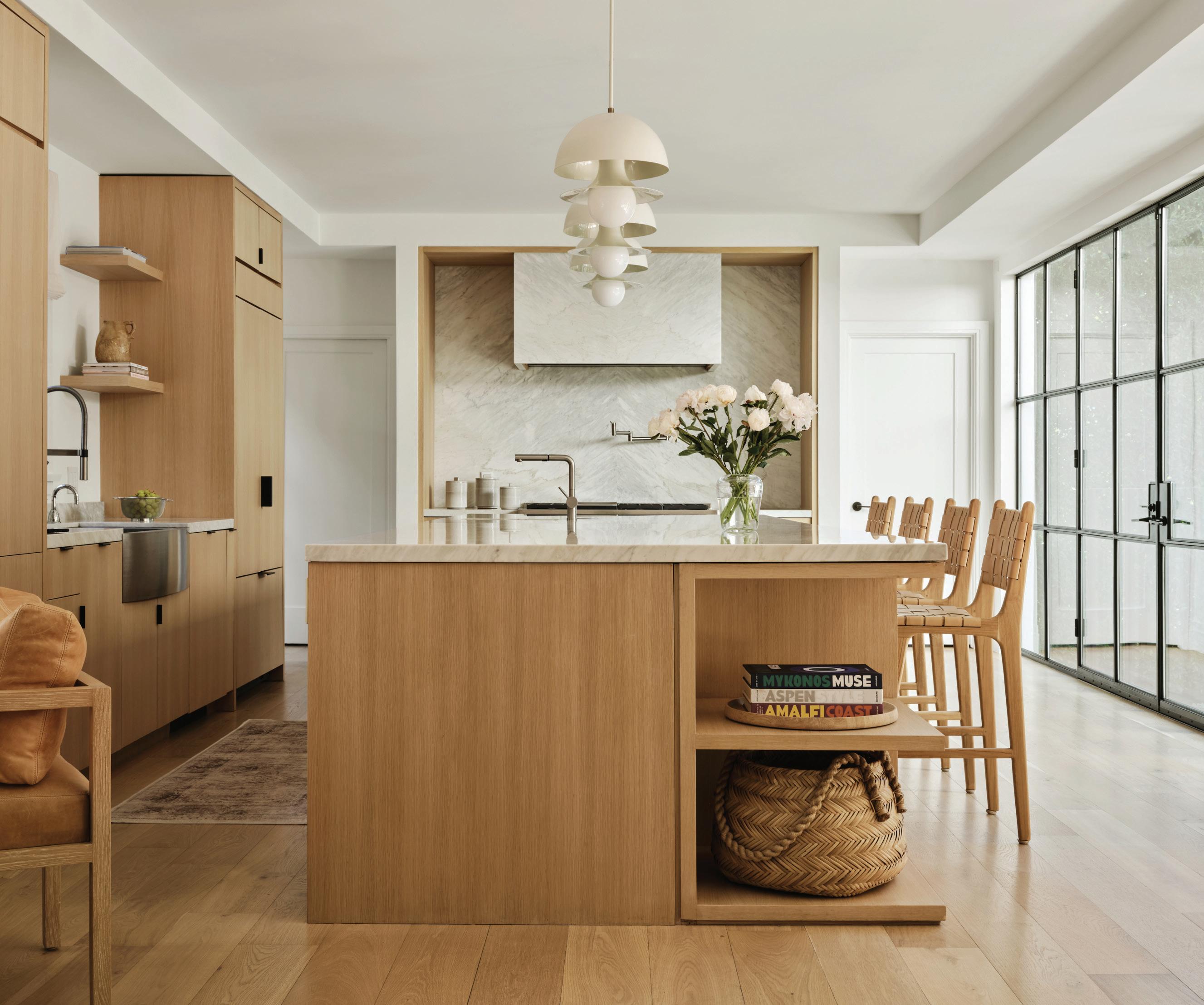
From an early age, designer
Jaqui Seerman had an eye for beauty and an innate sense of how to shape a space. Encouraged by parents who recognized her raw talent, she turned her childhood fascination into a flourishing interior design career spanning nearly two decades. Now, with years of experience crafting spaces that are as personal as they are visually captivating, Seerman shares her top tips for creating a home that is elevated and uniquely yours.
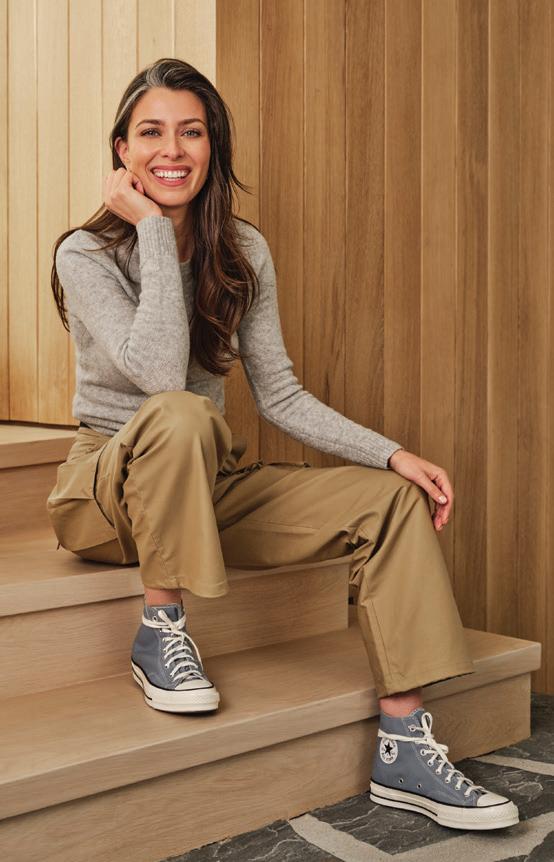
How did you begin studying design?
As an apprentice! I began as a design assistant to some of Southern California’s industry elites, first with Waldo Fernandez and later with Martyn Lawrence Bullard. During this time, I absorbed the intricate process of crafting a creative vision, building strong client-designer relationships, and managing the behind-the-scenes coordination essential to creating one-of-a-kind spaces.
How did you discover your unique style as a designer?
After nearly a decade in the industry, I decided to take the leap and start my own company. Though I was initially anxious about defining my own design identity, I was confident in my unique, client-first approach. Eight years later, we’re busier than ever,
“Painting the space — baseboards, walls, trim, and ceiling — in one hue creates a cocooning effect that feels both inviting and playfully sophisticated, all while remaining approachable and livable.”

continuing to provide top-tier client service and crafting beautifully designed legacy spaces.
How do you keep the design of each project fresh and new while staying loyal to your personal design style?
The design process is deeply personal. It’s essential to me that the spaces we create not only reflect the client’s lifestyle but also embody an elevated, well-curated aesthetic. This process varies for each client — some prefer to be deeply involved, while others prefer a more hands-off approach.
How do you approach learning about your clients to deliver spaces that truly reflect their taste and personality?
We use a “first thought, best thought” approach. We quickly present images and ask clients to share their likes and dislikes without hesitation or judgment. This method removes the fear of saying the “wrong” thing and encourages instinctive responses. It allows us to bypass formalities and get straight to understanding their preferences.

I’m a big fan of ambient and natural lighting, and I love creating spaces with a darker, moodier atmosphere.

How do you incorporate trends into your designs?
More often than not, the clients we work with are open to taking risks. Many come from creative industries and have a strong sense of self, making them willing to move beyond popular interior aesthetics and explore new, uncharted design territory.
What is the key to incorporating different colors, patterns, and textures in your projects without them becoming chaotic or too busy?
Enveloping a room in a single color from top to bottom is an effortless way to create maximum impact. Painting the space — baseboards, walls, trim, and ceiling — in one hue creates a cocooning effect that feels both inviting and playfully sophisticated, all while remaining approachable and livable. I love blending design styles, finishes, patterns, and materials. The more layered and curated a space feels, the more authentic and lived-in it becomes.
What role does lighting play in your
designs, and how do you select the right lighting for a space?
I’m a big fan of ambient and natural lighting, and I love creating spaces with a darker, moodier atmosphere. To achieve this, I often use decorative fixtures as statement pieces. I also appreciate the need for integrated lighting and love working with systems like Lutron, which allow for seamless transitions from day to night.
What role do you think art plays in completing a space, and how do you help clients choose the right pieces?
I love how art can enhance a space, but I also appreciate environments that are entirely void of it. Both aesthetics can be equally powerful. When advising clients on art selection, my main goal is to ensure they choose pieces that are personal and resonate with them. Art should be seen as a meaningful investment, not simply as an accessory to fill the wall.
What do you think is the most important element of a home’s design that people often overlook?
We always encourage our clients to think about where everyday essentials will be stored in their homes. A well-designed home isn’t just about aesthetics; it’s also about functionality. Thoughtful storage solutions play a key role in how a space performs.
How do you approach designing for families with children or pets, balancing style with practicality?
When designing for families, pet owners, or avid entertainers, durability is always a top priority. I love using natural materials like real wood, stone, wool, and cotton, as they perform exceptionally well in high-use spaces and can be restored over time. Along with beauty, I value stability and craftsmanship, paying close attention to how, where, and by whom each piece is made. An active household doesn’t require compromise — just thoughtful selections.
What is one design tip you live by?
Touch it once — if you can, invest in doing it right the first time. You’ll look back and appreciate that decision for years to come. ♦
By Emily Jaeger

From wraparound plant styling to limited-edition ceramic vessels, luxury plantscaping transforms your home into a verdant sanctuary.
Left:
Right: An inside look at the plant design studio.


Whether wandering through a quiet forest, tracing your fingertips along the rough bark; slipping through vines to a hidden cenote; or watching as flowers turn their faces toward the sun, plants and nature encapsulate joy and rejuvenation. This same energy is embraced in high-end residences through plantscaping — interior landscape design — to create serene, nature-infused spaces that elevate both the soul and the senses.
On the most basic level, plants purify the air in your home, but their benefits go far beyond that. Interacting with plants enhances mental well-being, lowers stress, and infuses spaces with a sense of calm. “There’s something deeply restorative about plants,” says Weslie Pierre, founder of the Bostonbased plant design studio Wesleaf. “Just having them in your space can reset your mind and bring your heart rate down.”
Plants can also become living keepsakes, deeply intertwined with your family story. Bari Ziperstein, artist and founder of BZIPPY, a luxury ceramic furniture and housewares company, shares that her interest in creating vessels for plants stemmed from her experience growing up around plants that had been in her family for decades. “My mother had plants she cared for over 35 to 40 years, and when she moved them, if a piece broke off, she wept for months. Those were her babies.”
Unlike other man-made features in the home, plants require a delicate balance of care

“There’s something deeply restorative about plants,” says Weslie Pierre, founder of the Boston-based plant design studio Wesleaf. “Just having them in your space can reset your mind and bring your heart rate down.”
and artistry to achieve the desired architectural aesthetic while ensuring optimal growth and vitality. And, like all living things, they can be a bit unpredictable. That’s where plant stylists such as Pierre enter to help homeowners achieve this living design element. “You can control the placement of furniture, but not a plant,” she explains. “Even if I tailor a plant for a space, in two weeks it will change — based on your energy, how you care for it, the light, the humidity. There’s just something about the uncertainty when it comes to plants that excites me.”
Pierre’s journey with Wesleaf began as
a pandemic pop-up, offering plant styling services that quickly gained a dedicated following. Today, her plant design studio is a go-to for high-end homes and designers in the Boston area, offering wraparound plant care from bespoke soil to preparing beloved plants for international travel with their owners. She also helps clients pick the perfect plant, not just for their lighting, but for their lifestyle. “When I first sit down with a client, I ask them: Who are you as a person? What does work look like for you? What does travel look like for you? It’s important that you find the right plant for your personality.”


During the pandemic, indoor gardens — entire plantscapes — became popular, Pierre shares. However, trends have evolved in the years since, shifting toward a more refined, minimalist approach. “Less is more now. Instead of creating expansive plantscapes, homeowners are opting for one statement plant and really learning how to care for it,” she says.
Minimalist rooms can be brought to life with just one sculptural piece, like a monstera or ficus, allowing homeowners to develop a deeper connection with the plant. Moss balls, or marimo, are particularly popular for their longevity — living up to 100 years. “They are often passed down as family heirlooms,” Pierre says, balancing a sense of tradition and heritage with new growth.
Pierre also recommends air plants, which can be seamlessly integrated into sleek industrial designs without soil. And no more fiddling with fiddle-leaf figs or other touchy plants. Instead, Pierre sees a rise in simple choices with a twist, such as moonshine snake plants. “It’s less about rarity now and more about the aesthetic of the plant.” Clients are choosing plants and vessels that fit their design vision, turning the plant into a living sculpture.
For Ziperstein, the vessel is as much a part of the artistry of plantscaping as the plant itself. Ziperstein’s pieces, showcased at BZIPPY
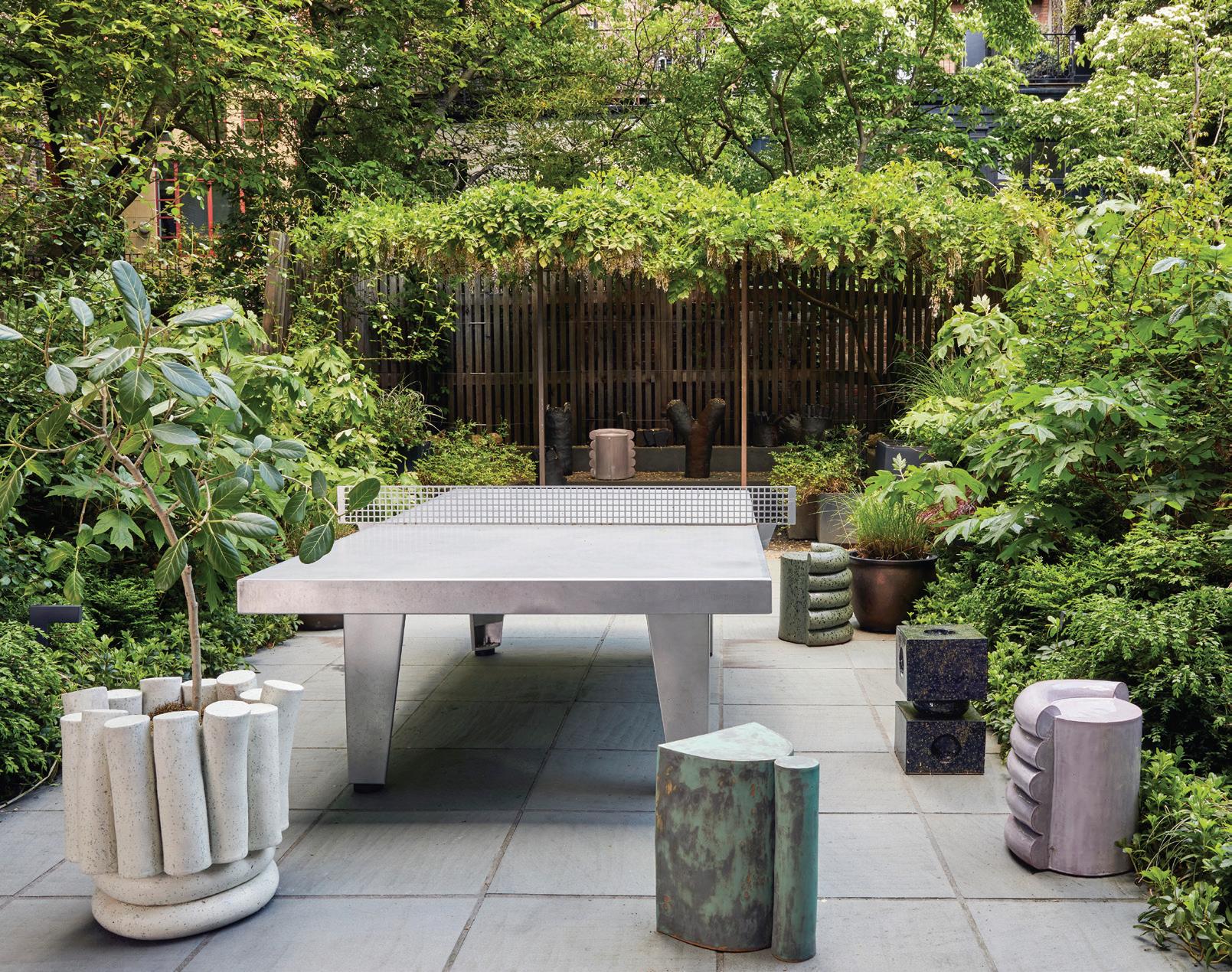
and in limited editions for Future Perfect, are renowned for their geometric, repetitive designs, which stand in bold contrast to the organic nature of plants.
Ziperstein draws inspiration from her daily drives through L.A., where urban infrastructure meets the natural landscape. “I drive my son to school and then to my studio, passing through urban environments, industrial landscapes, and then the mountains. I see everything from TV towers to fake cell phone trees,” she explains. These influences — from steel beams to Brutalist architecture — manifest in her work, merging industrial materials with the organic. “I call it the collage — that’s what my artwork is about — different elements coming together that shouldn’t be together.”
The dedication to sustainability and ethical production also sets Ziperstein’s work apart, making her pieces not just beautiful but consciously crafted. Creating one vessel, from sketch to finished product, takes about eight months, with each piece meticulously handcrafted to achieve both functionality and artistry. All materials are sourced and crafted with an emphasis on eco-friendly practices and ensuring her workers are well-paid and receive full benefits. “If we care about our plants, we should care about what they go in to,” Ziperstein says.
Ziperstein suggests pairing her vessels with vertically inclined plants, with minimal draping to fully appreciate the harmonious interplay between the plant and ceramics. ♦
Above: These colorful designs are by artist Bari Ziperstein, whose company, BZIPPY, creates unique ceramic furniture and housewares.
Below: BZIPPY produces planters and larger pieces, such as this table.
These influences — from steel beams to Brutalist architecture
— manifest in her work, merging industrial materials with the organic. “I call it the collage — that’s what my artwork is about — different elements coming together that shouldn’t be together.”
— Bari Ziperstein, artist and founder of BZIPPY
By Camilla McLaughlin

Once, it was Paris and London, but today, luxury travelers are raving about Greece as the ultimate destination for history, culture, luxurious stays, and more.
Maybe it’s a desire for authenticity, the allure of longlost worlds, or simply the promise of sun, white sandy beaches, aquamarine waters, and vibrant cuisine. Whatever the reason, this fabled country on the southern tip of the Balkan Peninsula is fast becoming the “it girl” of travel.
In 2023, international visitors to Greece reached a record high, and another benchmark is anticipated in 2024. It’s no surprise, as opportunities for adventure, heritage tourism, and luxury experiences continue to expand, while infrastructure improvements make it easier to visit more regions and islands.
“We have seen a surge of interest in Greece, particularly among families who make up 50 percent of our bookings to this Aegean country,” says Ayaka Hasegawa, senior public relations manager for luxury travel company Black Tomato.

One of the most beautiful hotels in Greece, the 100-year-old Poseidonion Grand Hotel takes center stage on the Spetses seafront.
It’s impossible to consider Greece without thinking of its many historical sites. Nowhere else do vestiges of the ancient and modern worlds intertwine in quite the same way. Near Athens, the Temple of Poseidon at Cape Sounion stands as a historic sentinel overlooking the Aegean Sea. The Acropolis, along with other monuments and museums, dominates Athens, a hub of the ancient world that is also a vibrant city today.
New additions to Athens’s hotel scene include the NEW Hotel, located among the ruins of the ancient city. A collaboration between notable artists and the Campana Brothers — the first Brazilian artists to exhibit
at the Museum of Modern Art — this hotel showcases Athenian-inspired art installations. Even for returning visitors, narrowing down destinations and determining the best ways to navigate the country is a challenge. With three surrounding bodies of water, more than 1,000 islands, and the longest coastline in the Mediterranean, Greece offers abundant choices.
Crete, the largest island and home to an ancient Minoan civilization, is renowned for historic treasures such as the Knossos Palace, a sprawling complex with vibrant frescoes, intricate architecture, and a history steeped
in myth and legend. Mykonos is ultra-exclusive, while a nearby island in the Cyclades chain, Santorini, is often considered the most breathtaking. Here, whitewashed buildings with iconic blue domes cascade along craggy volcanic cliffs to meet the deep blue Aegean Sea, filling an ancient caldera. Both islands offer ultra-luxury hotels and resorts designed to delight and pamper. The spa at NOUS, a clifftop resort overlooking the Santorini caldera, is inspired by ancient Greek principles of well-being and self-care.
Experts urge travelers not to overlook other islands. “You may be missing out if you think these are the only two worth visiting,”

One of Greece’s emerging art and design hotels, NOUS Santorini is a sprawling clifftop resort on the edge of the Santorini caldera.

Carved into a cliffside, Andronis Luxury Suites offer an ideal retreat.

says Max Barrett, who has composed a Greek travel blog since 1993.
“Sifnos is a small, leisurely island that is ideal for those seeking true relaxation and a slower pace,” observes Sunil Metcalfe, sales director at Black Tomato, noting that its beauty rivals that of Mykonos and Santorini. Privacy is enhanced by access limited to ferries, yachts, and private helicopters, making it ideal for ultra-wealthy individuals.
Paros is another recommendation. This picturesque island, with its famous whitemarble architecture, offers a blend of liveliness and understated elegance. Similar to Sifnos, “This alluring island has fewer crowds and offers low-key yet elevated experiences, from private yacht excursions along crystalclear waters to fine dining with local, gourmet cuisine,” says Metcalfe. “It’s a fantastic destination for those seeking privacy with plenty of secluded beaches, perfect for a tranquil, upscale escape.”
Spetses offers a unique experience, where horse-drawn carriages are the favored mode of transport. Though it’s near the Peloponnese on the mainland, Spetses feels like a world apart with mystical pine forests, charming paths, and hidden coves. Nothing captures the essence of Greek luxury more than the Poseidonion Grand Hotel. Founded over 100 years ago and “glamorous to its core,” this legendary hotel occupies a prime position on the Spetses seafront. Black Tomato names it one of the six most beautiful hotels in Greece, and they offer bespoke trips to this and other iconic hotels in the country.
In response to rising interest, luxury travel providers like Abercrombie & Kent and Black Tomato are refining offerings, adding curated itineraries and custom options geared to a range of ages and interests, often with private jets and yacht charters. The National Trust for Historic Preservation offers an island-hopping journey along the Cyclades and Peloponnese aboard the sailing yacht Le Ponant. Black Tomato offers custom itineraries crafted around premier hotels chosen by clients, as well as a newly designed trip for children inspired by the story of Hercules.
This destination defies the ordinary, reflecting a desire for authenticity that is reshaping luxury travel worldwide. Greece is leading the way, setting new records, and offering travelers unique experiences that celebrate its rich heritage, stunning landscapes, and timeless culture. ♦
The Four Seasons Astir Palace Hotel beach resort on the Athens Riviera offers a luxurious respite after a day touring the Acropolis.

In an era where nearly every special moment is captured on screen, live wedding painters are trending in the luxury realm as a way to celebrate fleeting moments in a lasting way.
The now-popular live wedding painter movement aligns with the demand for bespoke celebrations. Whether it’s a custom gown, unique invitations, unforgettable cakes, or a piece of artwork, the luxury market has seen an increase in tailored details. Live wedding painters are a one-ofa-kind addition to a special occasion. They capture the essence of the day, leave room for customization and input from the couple, serve as a form of entertainment at the event, and result in a cherished keepsake.
“A painting holds a unique significance because it encapsulates not just a moment, but the emotion, atmosphere, and essence of that
By Madeline Holmes
moment,” explains Linda Marino, a wedding painter based in Branford, Connecticut. In her five years of experience, she has painted over 100 weddings throughout New England and the East Coast.
Paintings in the Past
Capturing special events through art has a storied history, dating back to ancient Egypt, where celebrations were depicted through various mediums, including paintings, sculpture, architecture, and papyrus drawings. Medieval times featured illuminated manuscripts, while the Renaissance saw highly detailed, realistic wedding portrayals. In

the Victorian era, paintings were dramatic, reflecting the Romanticism movement. Though in different styles, wedding paintings throughout history have had the same goal: to capture the special day in a symbolic and visually pleasing manner. In today’s world, there’s been a resurgence in wedding paintings, partly due to the rise of social media. Clips and snapshots of wedding painters hard at work, portrait reveals, and guest reactions have gone viral, sparking this craze.
On the day, thousands of photos are usually snapped. Between photographers

Hope Sharp’s thoughtful rendering of a couple on their summer wedding day in the mountains of Stowe, Vermont.

Hope Sharp depicts a fall wedding in Hudson Valley, New York, including the couple’s beloved pet.
Left: A first dance at Tappan Hill in Tarrytown, New York, was captured in exquisite detail by artist Linda Marino.
Artist Courtney Kibbey uses watercolor to capture the essence of this couple’s first kiss.

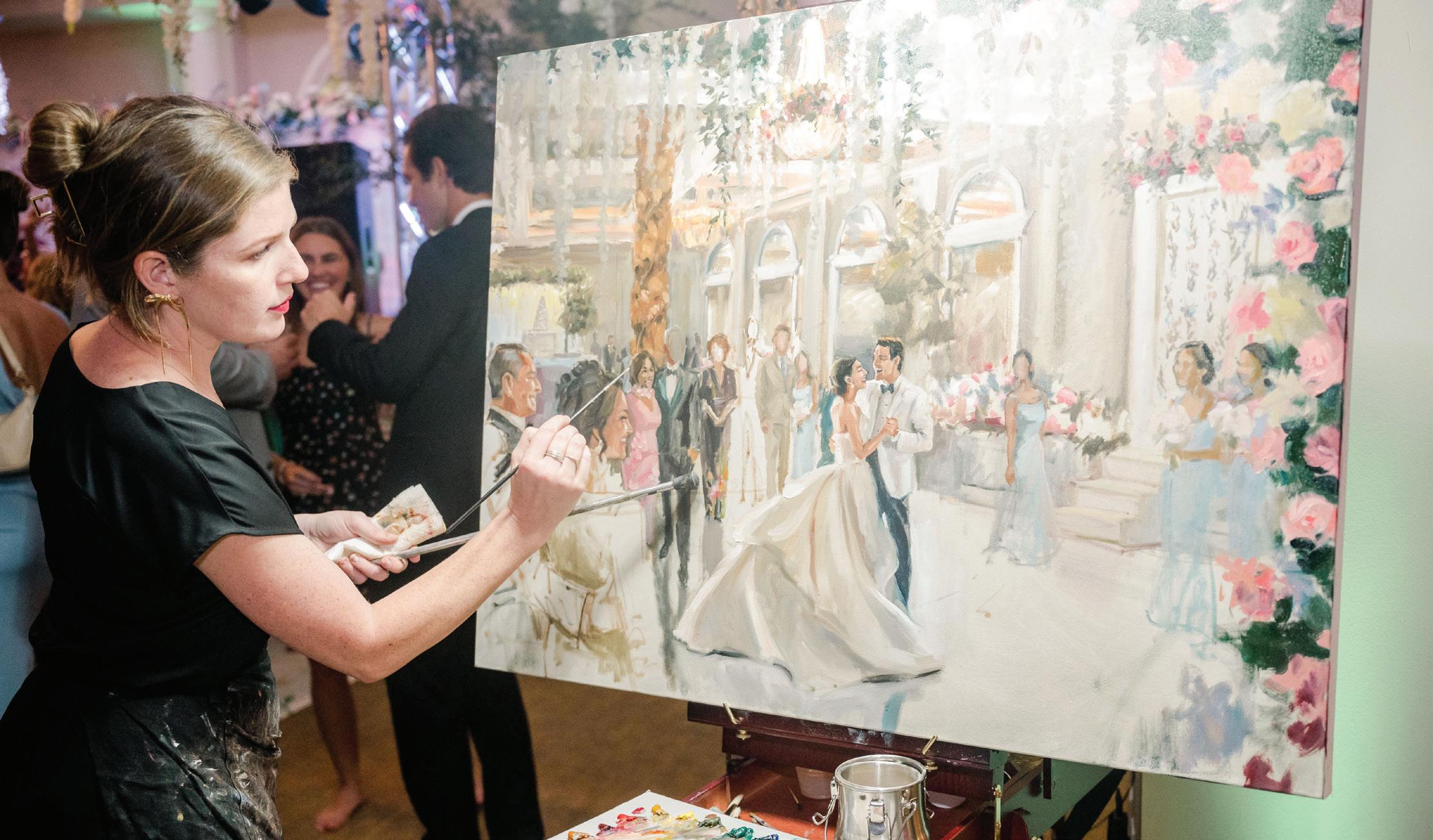
and guests, there are often enough photos to document an event minute by minute. A painting, however, can truly depict the spirit of the celebration. “As a painter, I have the ability to emphasize certain details, create a mood through color and composition, and weave together different elements of the day into a cohesive and timeless piece of art,” notes Marino. An artist is able to use their vision and skill to capture the magic of the guests, decor, and venue, and can even add details, whereas a photographer might only be able to document the scene right in front of them.
Hope Sharp, a luxury wedding painter based in Montpelier, Vermont, is a classically trained figurative artist whose medium is oil. When comparing paint and cameras, Sharp claims, “A painter gets to interpret and experience through our hands.” She often uses her artistic lens to make the moment she captures more symbolic, tweaking the spacing and colors to authentically convey the atmosphere at that precise moment. Painters utilize styles such as abstraction to make the piece more emotional. “There is nothing quite as expressive as a brushstroke,” Sharp adds. The painter refrains from starting her piece until she experiences “the moment” that she feels best encapsulates the significance of the day and aligns with the couple’s wishes. With this practice, her paintings are not generic
and genuinely represent a special moment between the couple.
In addition to capturing the deeper essence and the emotion of the moment, wedding painters are unique as they cater to the couple’s requests. Stephanie Gaffney, the New Orleans artist responsible for Torregrossa Art, also specializes in wedding paintings. She claims the best part of her work is that a painting can be whatever you want it to be. “Bad weather? Your artist can paint blue skies or a chromatic sunset. Awkward pose? The most skilled painters fully understand form and figure and can give you both a more flattering position on the canvas,” she explains. Gaffney frequently receives requests to paint absent loved ones, to include them in the celebration. Personal details such as these are becoming more and more popular, and each painting can be customized to suit the needs of the clients. “It’s kind of like a bespoke wedding gown because it was made special for you,” says Sharp.
Luxury wedding painters such as Courtney Kibbey from Tulsa, Oklahoma, work very closely with their clients to ensure satisfaction with the end result. She believes
“Bad weather? Your artist can paint blue skies or a chromatic sunset. Awkward pose? The most skilled painters fully understand form and figure and can give you both a more flattering position on the canvas,” Gaffney explains.
every painting is a unique and individual experience. “I create custom proposals for every project tailored to my clients’ needs, aesthetics, event size, timeline, and desired service,” says Kibbey. Moreover, she prides herself on providing clients with an “unparalleled experience saturated with southern hospitality.” Experienced wedding painters have an understanding of the luxury market and are able to exceed client expectations with their impeccable service and incredible talent.

The “live” aspect of wedding painting is an exhilarating experience for everyone in attendance. Sharp claims that, overall, it is a fun and pleasant way to entertain guests. “People see the crazy sketches I start with, and keep checking in with me to see the next level of progress.” Guests appreciate that they are a part of the special moment being captured on the canvas. Gaffney remarks, “People love the magic of it. The entertainment of watching an artist work is such an intimate process.” It becomes another moment of excitement for wedding guests to see the scene come to life and share their own insights. “When I’m painting, guests enjoy watching the process, chatting with me about the couple and sharing stories, and engaging with the piece,” notes Kibbey.
Live painting serves as entertainment, similar to a band or photo booth. It is the entertainer’s job to create an engaging atmosphere that guests will remember. Marino adds, “Much like a band or DJ sets the mood with music, I set the tone through the creation of art, capturing the spirit of the event as it happens.” Painting in and of itself is a performance, as the artist takes a blank canvas and turns it into something unique and beautiful. Kibbey believes the rarity and uniqueness of live wedding paintings
contribute to eliciting the “wow” factor among guests. She claims her role is to help guests “remember a wedding day forever, because it’s such an uncommon experience.”
The resulting artwork can be the perfect addition to a luxury home and display the elegance and sophistication of a wedding for years to come. A painting is timeless and commemorates an important day for the couple. Marino views the painting as “an investment in a piece of art that will be cherished for generations.”
“A painting can be something they enjoy over and over again and continue finding new elements,” says Sharp. A symbolic, largescale painting has many details that might not stand out upon the first few glances. Viewing a painting over time, a couple may discover new elements and meaning within the layers of paint. Kibbey aims to transport the couples back to their wedding day when they view her work by telling a story through her brushstrokes. Her goal is “to help my clients remember their wedding day in a piece they’ll love looking at every day for the rest of their lives.” ♦
“As a painter, I have the ability to emphasize certain details, create a moodthroughcolor and composition, andweavetogether different elements of the day into a cohesiveandtimeless piece of art,” notes Marino.
By Kassandra Burr
From rich velvet accents to fluted details, these luxury items are sure to cultivate an unforgettable experience.
A CAREFULLY PLACED ACCESSORY can quickly transform your dining area and elevate it to new heights. With arresting tableware, handcrafted pieces, and distinctive drinkware from luxury brands across the globe, you can curate a sophisticated spread for your table this season.
11 Burgundy Chair by Boca do Lobo
For a palatial setting, this plush chair is a quintessential piece of dining furniture. Drawing inspiration from surrealist artists like René Magritte and Salvador Dalí with its gravity-defying curved legs, the chair is fashioned of gold-plated, solid cast brass and finished with a varnish for proper protection. With a lavish, velvet seat and graceful features, such as its bow back rail and slender legs, the Nº 11 is a showstopper sure to delight guests.
Price upon request


Willamette 60” Linear Chandelier, Champagne Glass by Rejuvenation
Embrace the glamorous spirit of the Art Deco style with this delicately detailed chandelier. Handcrafted in Italy by glass artisans, the lustrous, grooved design of the champagne shade counterbalances sleek brass accents. “The fluted design diffuses a welcoming light in the vein of traditional crystal chandeliers,” notes Bo Knoblauch, director of design at Rejuvenation.
Originating in Paris in the 1910s, Art Deco — short for Arts Décoratifs — is characterized by rich materials, sleek lines, and geometric shapes. Borrowing elements from the design style, Rejuvenation’s dramatic, 60-inch fixture is a prime lighting choice for larger gatherings, as “the linear silhouette is perfect for extending light across longer dining tables.”
$3,479.00
Natural Linen Tablecloth with Velvet Border in Bordeaux by Once Milano
Once Milano’s graceful tablecloth makes for a truly indulgent dining experience. Woven from 100% handmade Italian linen, this timeless piece effectively marries the contemporary feel of linen with the classic, opulent feel of velvet. The silky trim, which is handmade in Venice, Italy, adds a tangible sense of luxury with its soft texture and deep, carmine hue.
$807.00


For wines that are best served chilled, such as white, rosé, or sparkling wines, this marble cooler makes an elegant choice. Ideal for dinner parties or outdoor events, the marble will keep wine at an optimal temperature, making the cooler both artful and functional. “With its beautiful fluted detailing, the handmade Esmeralda marble wine cooler would be an elegant addition to any table, with the benefit of keeping your wine cool and crispy throughout the evening,” says creative director, Annabelle Holland. Incorporate marble napkin rings or a serving platter for a cohesive look.
$254.00
La Fornasotta Set of Water and Wine Amber Murano Glasses for Six by Artemest
For an exclusive piece of glassware that tells a story, look no further than La Fornasotta’s Water and Wine Amber Murano Glasses, available at Artemest. An intriguing conversation piece, the set is handcrafted by master glass blowers on the Venetian Island of Murano using the “a Canna” technique in which canes of colored glass are melted into a base of clear glass. With captivating black and amber bands, these glasses dually serve as both drinkware and art.
$1,505.00

By Emily Jaeger
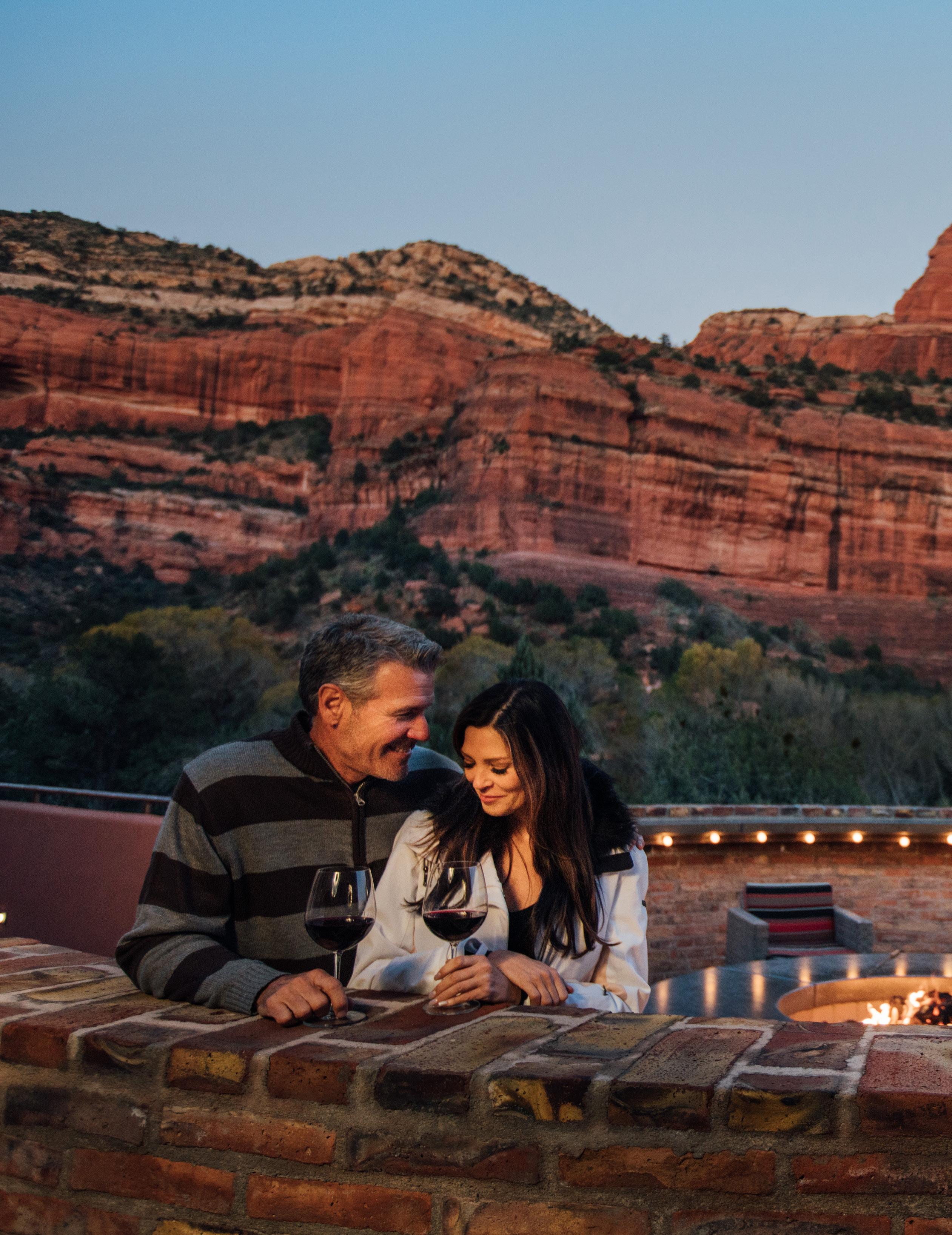
Discover the mystical allure of the West and cultivate your inner calm with transformative wellness experiences, from luxurious spa treatments to guided vortex hikes.
Sedona, Arizona, with its spectacular red rock spires, is often hailed as the most magical place in the United States, drawing luxury wellness seekers from across the globe to its sacred and powerful landscape. Renowned for its transformational energy, this vibrant desert oasis offers a profound escape for those yearning to rejuvenate the mind, body, and soul.
“I think that one of the reasons it’s becoming more popular is probably because more people are realizing that they don’t want to settle for a mediocre life,” shares Irina Litvin, co-founder of One Tribe Tours. “Often led by curiosity, they find their way to the sacred land of Sedona looking for ways to bring more balance, fulfillment, and meaning into their lives.”
As a premier destination for luxury wellness, Sedona offers world-renowned

retreats with an array of holistic healing practices and indulgent treatments. Whether indulging in desert flower massages, guided spiritual hikes, or sound healing sessions, the luxurious pampering available at these retreats is matched only by the deep sense of peace that the land itself offers. This is a place where the extraordinary beauty of nature intertwines with restorative experiences, allowing for true serenity and transformation.
Vortex Tours and Spiritual Hikes
The area’s famed vortexes contain powerful energy currents believed to promote healing, clarity, and spiritual growth. A vortex is not a visible phenomenon but an energetic field that can be felt, offering varying frequencies and effects. Although all of Sedona is considered a vortex, there are specific sites where the
A natural hot spring at Castle Hot Springs provides mineral-rich waters, abundant in lithium, magnesium, and bicarbonates, known to boost mood, soothe the mind, and relieve sore joints and muscles.
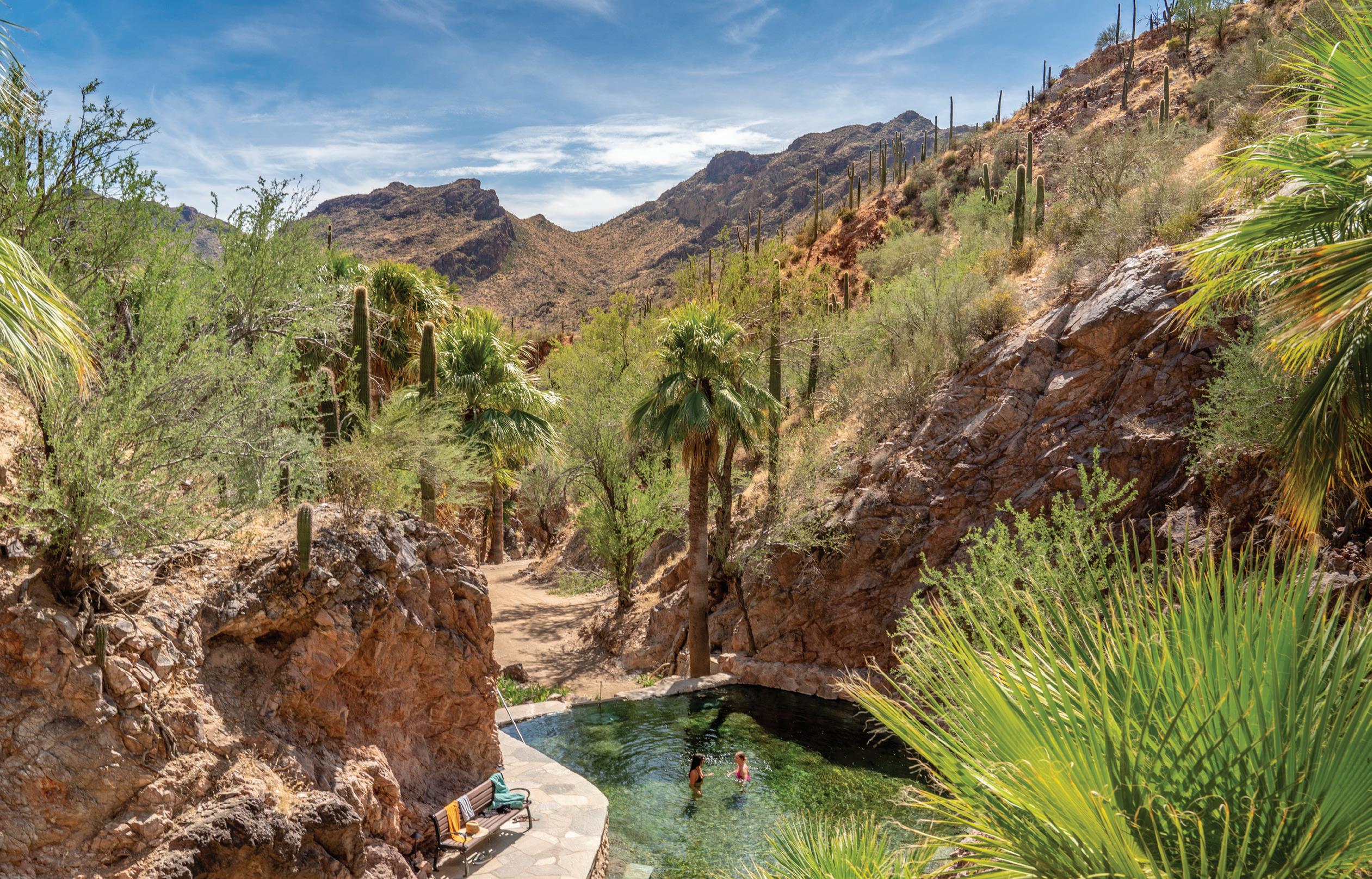
energy can be felt more intensely. Each site carries its own quality of energy, from calming and nurturing to invigorating and uplifting, making every visit a distinct experience.
One Tribe Tours, founded in 2011 by a husband-and-wife team deeply attuned to Sedona’s spiritual energy, offers transformative vortex tours and spiritual hikes for those seeking deeper connection and healing. “Our journey began with a whisper from the desert, calling us to share Sedona’s mystical energy with others,” says Litvin. Since then, they have combined their training in Kundalini yoga, practical metaphysics, and somatic healing to craft deeply personalized experiences for their guests.
On a vortex tour with One Tribe, guests are guided through these energy-rich sites with care and intention. The journey transcends a simple hike; it’s a spiritual experience designed to help guests reconnect with their true essence. “People come to Sedona to heal, to find inspiration, to find clarity, to receive messages and ideas from the spiritual realm,” shares Litvin. The experience is deeply personal, with sensations ranging from a gentle tingling to profound emotional release, or even visions of colors and euphoric states.
“What brings us the most joy is seeing how people light up, shedding loads of stress
off their shoulders, becoming more present and more alive,” says Litvin. “We’re inspired by helping people experience the magic of the moment.”
Castle Hot Springs
Next, venture to Castle Hot Springs, a secluded resort tucked away in the rugged Bradshaw Mountains — the perfect escape for those seeking wellness and serenity. Just a two-hour drive from Sedona, this historical resort has been cherished since the 19th century for its crystal-clear, mineral-rich waters, which naturally flow from deep within the earth.
Carved into the canyon rock, three natural pools offer pure, scentless water that is rich in healing minerals such as lithium, magnesium, and bicarbonates. These work to calm the body, reduce inflammation, and improve circulation. The soothing warmth of these waters, combined with the peaceful desert landscape, creates an environment where stress melts away, leaving behind a profound sense of relaxation and renewal.
“This place is meant to be a wellness retreat,” shares Robert Stackus, Castle Hot Springs’ spa director. “I love being here with the sounds of the stream, the wind, and the birds. At Castle Hot Springs, we have a unique opportunity to embrace the calming effects
of nature and to help guests reconnect with themselves and their bodies.”
Indeed, the natural surroundings play an essential role in the healing experience. The trilling of cactus wrens, the rustling of mesquite leaves, and the gentle flow of water over rocks create a symphony of sounds that lull guests into a state of peace. Even the smallest details, such as the flutter of butterfly wings or the scamper of a lizard on a sun-warmed trail, add to the immersive tranquility of this desert retreat.
L’Apothecary: Sound Healing and Desert Flower Massage
Reconnect with nature and embrace the profound healing energy of Sedona at L’Apothecary Spa at L’Auberge de Sedona. Set amidst the tranquil beauty of a lush forest and the soothing sounds of rolling waters, L’Apothecary offers a truly immersive experience where nature is both the setting and the inspiration.
One of the most distinctive offerings at L’Apothecary is the practice of sound healing, a luxurious and deeply meditative treatment that has been growing in popularity. “We have seen sound healing grow as a popular luxury trend, both in Sedona and at large,” explains spa director Joy Gosser. “The practice helps

Taking in Arizona’s serene beauty from above, these hikers embrace the landscape’s quiet majesty. There’s no better way to appreciate the Southwest’s natural wonders than by exploring them on foot, one breathtaking view at a time.

The L’Apothecary
people disconnect from their busy (and at times, stressful) lives to be still and tune into rhythmic sounds during a session.”
Sound healing works by sending sound waves throughout the body, which bring harmony through oscillation and resonance. During a session, guests close their eyes
and allow themselves to be enveloped by the sounds of vocal harmonics, singing bowls, chimes, and drums.
The energy healer uses these vibrational instruments to guide the body into a deep, meditative state.
It’s a practice designed to realign the body’s frequencies, promoting optimal health and vitality.
This ancient technique can help alleviate physical ailments, emotional stress, and energetic blockages, making it a powerful tool for wellness. Gentle waves of sound wash away tension and restore balance to the body and mind.
For those seeking a more traditional yet uniquely Sedona experience, the Desert Flower Massage at L’Apothecary Spa harnesses the healing properties of the region’s native plants. This signature massage combines jojoba and avocado oils with essential oils of sage, lavender, and calendula — each chosen for its restorative and spiritual
properties. These hyper-local desert herbs connect guests to the rich natural landscape that surrounds Sedona.
The massage incorporates Swedishinspired techniques, which are both soothing and revitalizing. Sage, known for its ability to clear negative energy, is a key component of this treatment, helping guests feel more grounded and spiritually cleansed. The addition of calendula, celebrated for its skinsoftening and healing properties, ensures the body is left nourished and refreshed. Lavender, renowned for its calming effects, is used to relax both the mind and spirit, making this treatment a holistic remedy that addresses physical, emotional, and spiritual well-being.
The desert herbs chosen for the Desert Flower Massage are not just therapeutic but are also deeply symbolic of the region. Sage and calendula, in particular, have been used for centuries by Native American cultures for their healing properties and their ability to promote prosperity and remove unwanted energy. “The combination of the two is a wonderful addition to a massage for guests seeking a traditional ‘Sedona’ experience,” shares a therapist at L’Apothecary. “Guests often feel more relaxed and clear-minded following the session, leaving behind things that no longer have a purpose for them.” ♦
By Roger Grody

Designers and engineers are developing innovative approaches to fireplaces, resulting in architectural features that ignite the imagination.
PHOTO BY ALEX STEIN
Noarchitectural element anchors a room as effectively as a fireplace, and nothing generates more warmth or emotion, even after the embers have cooled. Architects and interior designers are pushing the limits of creativity with dramatic fireplaces that demand attention.
CF + D specializes in the design and construction of custom fireplaces, and the Canadian firm challenges traditional perceptions of what a fireplace should look like without compromising the warmth and emotional impact of this ancient architectural feature. CF + D CEO Vince Volpe suggests fireplaces represent “love made visible,” a phrase derived from the writings of Lebanese American poet Kahlil Gibran. Some of the company’s designs feature soaring, futuristic forms suspended more than 40 feet from high ceilings. “We take a client’s inspiration and make it a reality,” explains Volpe. Of his designers’ and engineers’ capabilities, he says, “If it can be imagined, it can be built.” He adds, “We do what others believe cannot be done.” The company recently completed a 70foot copper and blackened steel installation — the largest indoor fireplace in North America — at the BMO Centre in Calgary.
The Four Seasons Hotel and Private Residences Telluride takes full advantage of an extraordinary backdrop: the rugged, snowblanketed San Juan Mountains. Contemporary homes, designed by Olson Kundig, feature floor-to-ceiling glass walls that fully retract to erase boundaries between indoors and out, and dramatic fireplaces bring warmth to these Colorado residences. “Four Seasons Hotel and Private Residences Telluride is bringing an exceptional new lifestyle experience to this special town, so we knew the design had to make an incredible impression,” explains

Canada’s CF + D specializes in unique, avant-garde fireplaces, such as this work of art that appears to hang from the ceiling.
Dev Motwani, president and CEO of Merrimac Ventures, which is developing the project alongside Fort Partners. “Each residence features an indoor fireplace that makes a grand design statement,” adds Motwani.
The Olson Kundig-designed homes at Four Seasons Telluride are consistent with the Seattle-based architecture firm’s signature style of introducing bold, contemporary aesthetics to rustic, pristine settings, whether a Costa Rican rainforest or an Idaho lakefront. In most of these residences, fireplaces warm the modern designs while providing unique opportunities for the architects to explore rich textures and compelling details. Olson Kundig principal and owner Kirsten Ring Murray reports, “Although we no longer rely on fireplaces for warmth and light, gathering
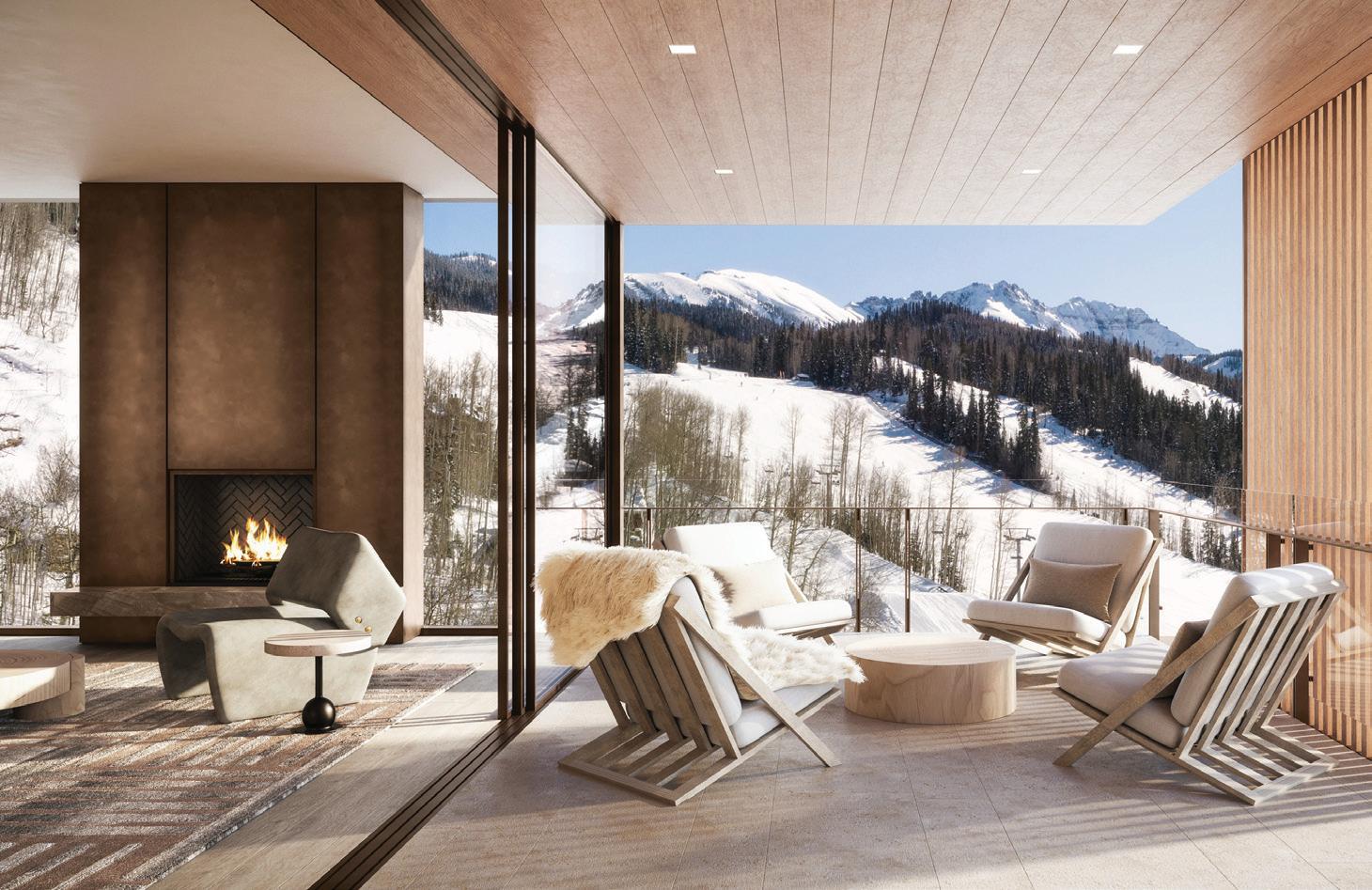
At Four Seasons Private Residences Telluride, architects Olson Kundig use fireplaces to create powerful statement, such as this one framed by floor-to-ceiling glass.
around them taps into a primal sense of comfort that’s endured for generations.” With today’s fireplaces playing a vital role in both the aesthetics and experience of home, Ring Murray explains, “In contemporary design, fireplaces provide that touch of rich, permanent materiality, grounding the space and connecting it to the site.”
Steps from the Guggenheim Museum on Manhattan’s ever-fashionable Upper East Side is 180 East 88th Street, a luxury condominium development whose penthouse was featured in the HBO series Succession. In the lobby, a curvaceous ceiling — Antoni Gaudí has been suggested as a possible inspiration — soars above Italian travertine flooring inlaid with Austrian white oak. A focal point of the space is a grand fireplace carved from sculptural arches enhanced by renowned German plaster artist Jan Hooss. Developer Joseph A. McMillan, founder and CEO of Azur and DDG, reports, “The eye-catching fireplace with arched ceilings and beautiful surrounding décor makes a bold statement, providing a dramatic yet intimate welcoming arrival for our residents.” He adds, “Complete with the specially commissioned stucco installation, the fireplace becomes a one-of-a-kind art piece, continuing our commitment to fusing art and architecture.”
At a private residence in Orange County, California, designer Lisa Slayman created a stunning backlit onyx fireplace that appears to glow like hot embers. And for nearly a century, guests have warmed their bodies and souls around a monumental stone fireplace at the Fairmont Le Château Montebello in Quebec. The 65-foot-high hexagonal structure is the centerpiece of the hotel’s atrium, one of the best places in the province to sip a hot toddy. ♦

Keeping a finger on the pulse of high-end living means staying attuned to the latest in luxury trends. From color palettes to sustainable materials, here is what experts say is shaping today’s most exquisite interiors.


“All-white interiors are giving way to rich, earthy palettes that evoke warmth and a sense of history. We’re especially drawn to deep, enveloping hues like rust, olive, and merlot that lend a collected, timeless feel to a space.”
— Kasandra Rafter, founder and designer at Canyon Creative Design
“In an age where there’s an increasing consciousness about the impact of our choices on the environment, we believe that home decor should not only be beautiful but also ethical,” says a spokesperson from Braided-Rug Co.
“Yes, innovation in materials is a key trend for 2024. We’re seeing rugs made from recycled and upcycled fibers, such as plastic bottles and fabric scraps. Organic and natural fibers like jute, bamboo silk, and organic cotton are also becoming more common.” — Filipa Mendonça at Caffe Latte Home.
“The era of soft neutrals is shifting towards vibrant jewel tones in upholstery and rugs. Jewel-toned fabrics bring fun, sophistication, and a touch of whimsy to interiors. At Canyon Creative, we adore the richness these colors introduce, whether through a bold sofa, an accent chair, or a vintage rug that anchors the space.”
— Kasandra Rafter, founder and designer at Canyon Creative Design 1 2 3

Crafted with meticulous attention to detail, Park Place on Gulf Shore will feature 15 exclusive residences, each with breathtaking views of the Gulf of Mexico and one of Naples’ most exquisite bays, Naples Bay. Here, you will discover a luxury living experience in a location that stands unrivaled.
3,175 to 3,790 A/C sq. ft. | Private elevator access | 2 designer finishes/selections options | 8” wide plank oak wood flooring | Smart Home ready: pre-wired for motorized shades, lighting control system and thermostats Sub-Zero wet bar including wine tower & undercounter refrigeration | Expansive outdoor living areas with porcelain tile flooring and built-in 36” Wolf gas grill & hood | Dornbracht plumbing hardware | Polished chrome Emtek interior door hardware | Pet-friendly building | Energy-efficient hurricane windows | 2 assigned, under-building parking spaces | Electric car-charging stations | Individual personal storage | Professional building management | Pre-Construction pricing ranges from
CHEF-INSPIRED KITCHENS
Quartzite countertops | Wolf 36” gas range with 6 burners & 30” speed oven | 48” Sub-Zero refrigerator | Miele dishwasher | Custom cabinetry | Undermount Silgranit sinks | Designer faucets & cabinet hard-
RESORT-STYLE AMENITIES
11 boat slips for boats up to 32’ & up to 10' beam | Bayfront, resort-style pool | Sunrise & sunset private roof decks with: Kitchen & bar, Covered seating areas, Lounge chairs, Expansive sun deck with lounge seating | Open-air, rooftop fitness area | Trellised outdoor seating areas | Firepit and seating area | |

Please call Frank Petras at (239) 595-2221 for floor plans and more information.
Frank Petras
John
R. Wood Christie’s International Real Estate

Over the last 20+ years, Frank Petras, your neighborhood REALTOR®, earned an unrivaled reputation as a unique market expert, with a law degree and a master’s degree in marketing and finance, who simplifies the buying and selling of Naples high-end real estate. Give him a call at (239) 595-2221 to see if there is a fit for working with each other. Frank would love to hear from you!